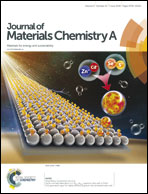Sprinkling MnFe2O4 quantum dots on nitrogen-doped graphene sheets: the formation mechanism and application for high-performance supercapacitor electrodes†
Abstract
Quantum dots (QDs)/graphene composites are interesting as promising electrode materials for high-performance supercapacitors because they can well integrate the complementary features of QDs and graphene. Herein, we demonstrate a MnFe2O4 QDs/nitrogen-doped graphene (NG) material prepared by a controllable solvothermal synthesis, in which ultra-small MnFe2O4 QDs are uniformly anchored on NG surfaces. First-principles calculations elucidate that the oxygen-containing groups of graphene oxide play a crucial role in generating such a structure, and a ferrite octahedral skeleton is firstly formed followed by Mn atom insertion. Powdery MnFe2O4 QDs/NG exhibits a high specific capacitance of 517 F g−2 within a negative potential window (−1 ∼ 0 V) in KOH electrolyte. When the lower cut off voltage is extended to −1.2 V, the specific capacitance can be increased to 905 F g−1. And the condensed MnFe2O4 QDs@NG electrode (forming a similar structure to pitaya slices) with an astonishing loading mass of 18 mg cm−2 can achieve high areal and volumetric capacitances (5.3 F cm−2 and 277.6 F cm−3). Moreover, carbon encapsulation is favorable for the improvement of rate and cycling performance, allowing a satisfactory capacitance of 150 F g−1 even at 200 A g−1 as well as a superior lifetime up to 65 000 cycles. These results make such materials competitive with supercapacitor electrodes and may speed up the development of QD-based electrodes for energy storage applications.



 Please wait while we load your content...
Please wait while we load your content...